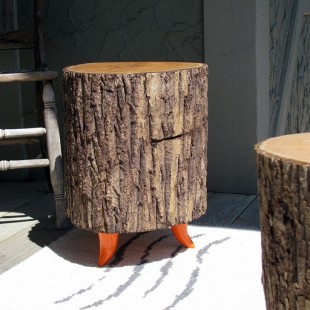La deuxième vie d’un arbre par Nickadoo
Vu d’une perspective large, presque philosophique, la forêt ressemble à n’importe quel autre organisme vivant. Chaque jour des cellules, ici des arbres, meurent et sont remplacées par de nouvelles, des pousses. Nicole Bélanger a trouvé un moyen de donner aux arbres tombés dans les forêts du Lac Brome une nouvelle vie et une fonction totalement différente.
Récupérant les arbres tombés sous les coups de la nature ou ceux des bûcherons, elle leur donne un avatar, une renaissance, une nouvelle vie. Chaque arbre est alors coupé soit en plaques pour en faire des tables ou des consoles, soit en troncs qui seront éventuellement transformés en tables d’appoint.
Bélanger nettoie chaque pièce sans utiliser de produits chimiques et les met au séchoir pendant quatre à six semaines pour les débarrasser des bactéries, insectes, champignons et autres moisissures. Ainsi chaque pièce peut être placée à l’intérieur sans danger. Elles sont polies à la main après plusieurs ponçages, les côtés recouverts d’un scellant non toxique, et les dessus lustrés d’une cire d’abeille produite localement.
Travaillant chaque pièce comme s’il s’agissait d’un canevas, Nicole Bélanger fait apparaître la vie intérieure du bois, son âme, en laissant s’exprimer le grain, les anneaux d’âge et les diverses couches d’écorce. Elle explore ensuite leurs anecdotes comme les estafilades laissées par les bûcherons, les griffes d’ours, les dents de castor ou les bois de cerfs en les intégrant au tableau final.
La dernière étape, en ajoutant des pattes, les transforme en œuvres d’art fonctionnelles d’une tournure différente. D’une certaine façon elles semblent revivre à nouveau et on dirait qu’elles marchent. Chaque arbre connaît alors une évolution qui transforme les pièces individuelles dont elles sont extraites. De leur état originel elles deviennent des objets à la fois esthétiques et fonctionnels tout en conservant leurs vertus naturelles.
Ce dernier aspect est probablement ce qui importe le plus à Nicole Bélanger. Pour elle : «De la sélection de l’arbre jusqu’aux détails du processus de design, chaque décision est importante. Le travail manuel est une joie. Je crois fermement que cela découle d’un grand respect pour la forêt et les arbres qui en sont la mémoire.»
A tree’s second life by Nickadoo
Viewed from a wide, almost philosophical, perspective, a forest is like any other living organism on this earth. Any odd day some cell – in this case a tree – will die, to be replaced by a new cell, in the forest’s case a sapling. For the fallen trees that strew the forests in their Brome Lake area, Nicole Bélanger of Nickadoo has found a way to give them a new and altogether totally different purpose.
She salvages the logs or trees either taken down by the forces of nature or knocked down from lumber activity and then strives to give them a new life, a rebirth, an avatar. Each tree is then cut either in slabs that will become coffee tables or consoles, or stump size logs that will eventually be transformed into side tables.
Bélanger then cleans each piece without using any chemical and has them kiln-dried for four or more weeks to remove of all bacteria, bugs, mold and mushrooms. In this way, every piece is guaranteed to be safe for indoors. After multiple and lengthy sandings and hand-polishing, the sides are coated with a non-toxic water base sealant and the tops shined with a locally produced bee’s wax.
Working on each piece as if it was an individual canvas, Nicole Bélanger reveals the inner life of the log, its soul, by letting the grain of the wood, the age rings, and the different layers of bark express themselves. She then explores any life stories and anecdotes such as gashes from the woodcutters, bear claws, beaver teeth and or deer antler marks and make them part of the total picture.
The final process, by adding legs, transforms them into functional pieces of art, but with a twist. In a way, they seem to come alive once again and almost look as if they were on the move. Each tree thus goes through a form of evolution that transforms the individual pieces made out of it from their original state into an object that is both aesthetic and useful while keeping their natural virtues.
That last aspect is probably the most important in Nicole Bélanger’s mind: «From the selection of the logs to minute details of the design process, each decision is important to me. The hands-on work is a joyful process. But I believe it all stems from the respect for the forest and the trees that are its memory»
